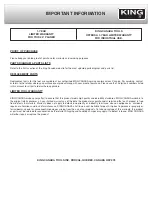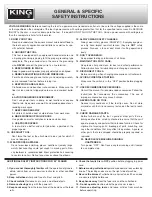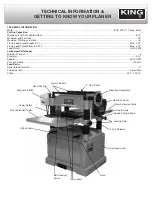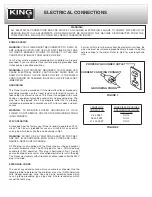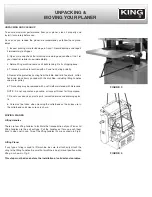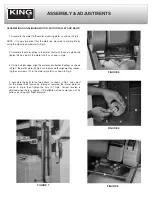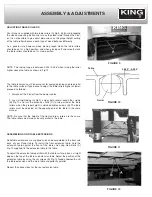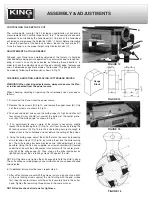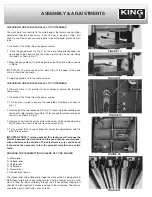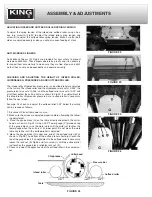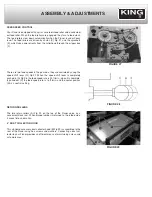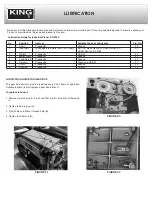
ASSEMbLY & ADJUSTMENTS
CONTROLLING THE DEPTH OF CUT
The cutting depth scale (A) Fig.13 includes a combination of inch/metric
measurements with a cutting range from 0” to 8”. The upward or downward
movement is controlled by the handwheel (B). One turn of the handwheel
will increase or decrease the height by 0.059” (1.5mm). Before attempting
to move the position of the head up or down, loosen the lock knobs (C).
Once the head is in the proper height, retighten lock knobs (C).
ADJUSTEMENTS & TOOLS NEEDED
Although your Planer was carefully adjusted at the factory, it should be
checked before being put into operation. Any accuracies due to rough han-
dling in transit can easily be corrected by following these directions. In
order to check the adjustments you will need a straight edge, feeler gauge
and a homemade gauge block made of hard wood. This gauge block can
be made by following the dimensions shown in Fig.14.
CHECKING, ADJUSTING & REPLACING CUTTERHEAD KNIVES
WARNING! When checking adjustements, always make sure the Plan-
er is disconnected from the power source.
When checking, adjusting or replacing the cutterhead knives, proceed as
follows;
1. Disconnect the Planer from the power source.
2. Remove the six screws (A) Fig.15, and remove the upper cover (B). Only
4 of the 6 screws are shown in Fig.15.
3. To check and adjust knives, use the knife gauge (A) Fig.16 and check all
four knives. Knives should just contact the bottom of the center protru-
sion (B) of the knife gauge, as shown in Fig.16.
4. If an adjustment to one or more of the knives is necessary, slightly
loosen the knife locking bars (C) Fig.16, of all four knives by turning the
24 locking screws (D) Fig.16 into the knife locking bars just enough to
relieve stress in the cutterhead and not disturb the setting of the knives.
5. Using the knife gauge, adjust the knife that must be reset by loosening
all six locking screws (D) Fig.16, by turning them into the knife locking
bar. The knife locking bar becomes loose and knife adjustment is now
possible. Using the hex. key supplied, unscrew Jackscrews (E) located
under the knife until the knife comes into contact with the center protru-
sion (B) of the knife gauge (A). Then snug up the knife locking bar by
lightly backing out the six locking screws (D) against the slot.
NOTE: At this time, only tighten the knife enough to hold the knife in place.
The knife will be secured properly once all other knives have been checked
and adjusted.
6. If additional knives must be reset, repeat step 5.
7. After all four knives are set with the screws just snug, back out and tight-
en the six locking screws against the slot starting with the end screws
first, then the center screws until the knife is securely held in the cutter-
head. Tighten the remaining three knives in the same manner.
NOTE: Double check all screws for tightness.
FIGURE 13
b
A
C
FIGURE 14
FIGURE 15
FIGURE 16
Gauge
block


